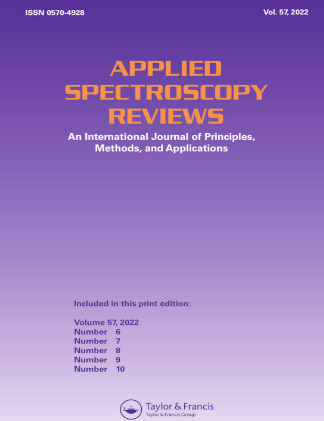Spectroscopic methods for determination of critical micelle concentrations of surfactants; a comprehensive review
IF 5.4
2区 化学
Q1 INSTRUMENTS & INSTRUMENTATION
引用次数: 27
Abstract
Abstract The applications of surfactants in various fields are gaining more attention, which makes full characterization of surfactants of growing interest. It is fundamental to measure the critical micelle concentration (CMC) as a parameter for characterizing surfactants. Spectroscopic methods for determination of CMC are more common, easier to perform, and in certain applications more accurate. In this review, different spectroscopic techniques and methods used for determination of CMC are discussed. These methods include direct UV/VIS Spectroscopy, which studies liquid surface curvature in thin wells using vertical detecting light beam with the wavelength set at 900 nm. The indirect UV/VIS Spectroscopic methods include using surface plasmon resonance or surface-enhanced Raman scattering of metal nanoparticles. Direct spectrofluorometric methods measure CMC based on the intrinsic fluorescence of the tested surfactants, and it was reserved for surfactants with intrinsic fluorescence such as Triton-X100. Indirect spectrofluorometric methods include measuring the change in fluorescence intensity, spectral shape, lifetime, polarization, or the solvatochromic shift of surfactant-dye solution. Other spectroscopic methods have been reported such as X-ray diffraction, nuclear magnetic resonance spectroscopy and small-angle neutron scattering. This review article discusses the spectroscopic methods developed for CMC determination with emphasis on the principle, applications, advantages, and limitations of each method.测定表面活性剂临界胶束浓度的光谱方法。全面回顾
摘要表面活性剂在各个领域的应用越来越受到人们的重视,因此对表面活性剂的全面表征日益引起人们的兴趣。临界胶束浓度(CMC)的测定是表征表面活性剂性能的基础参数。光谱法测定CMC更常见,更容易执行,在某些应用中更准确。本文综述了测定CMC的不同光谱技术和方法。这些方法包括直接紫外/可见光谱学,利用波长为900 nm的垂直探测光束研究薄井中的液体表面曲率。间接紫外/可见光谱方法包括利用金属纳米颗粒的表面等离子体共振或表面增强拉曼散射。直接荧光光谱法是根据被测表面活性剂的本征荧光测定CMC,只适用于具有本征荧光的表面活性剂,如Triton-X100。间接荧光光谱法包括测量荧光强度、光谱形状、寿命、极化或表面活性剂-染料溶液的溶剂变色变化。其他的光谱方法如x射线衍射、核磁共振光谱和小角中子散射等也有报道。本文综述了近年来发展起来的用于CMC测定的光谱方法,重点介绍了各种方法的原理、应用、优点和局限性。
本文章由计算机程序翻译,如有差异,请以英文原文为准。
求助全文
约1分钟内获得全文
求助全文
来源期刊

Applied Spectroscopy Reviews
工程技术-光谱学
CiteScore
13.80
自引率
1.60%
发文量
23
审稿时长
1 months
期刊介绍:
Applied Spectroscopy Reviews provides the latest information on the principles, methods, and applications of all the diverse branches of spectroscopy, from X-ray, infrared, Raman, atomic absorption, and ESR to microwave, mass, NQR, NMR, and ICP. This international, single-source journal presents discussions that relate physical concepts to chemical applications for chemists, physicists, and other scientists using spectroscopic techniques.
 求助内容:
求助内容: 应助结果提醒方式:
应助结果提醒方式:


